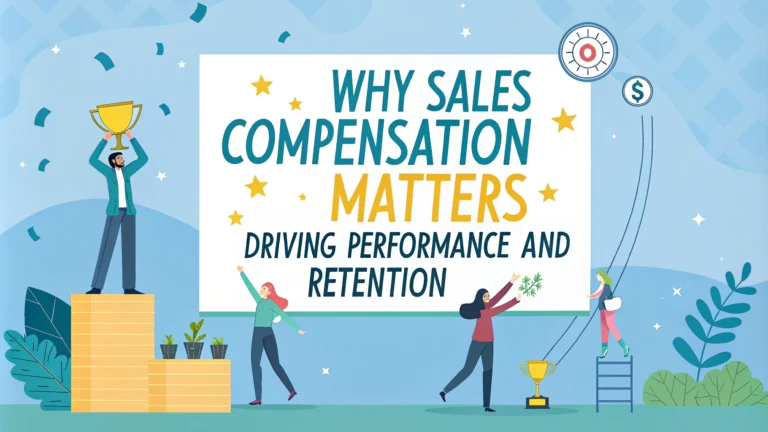A well-crafted sales compensation plan serves as the backbone of a high-performing sales organization.
It acts as a powerful tool to attract top talent, motivate existing team members, and align individual efforts with company goals.
When designed effectively, compensation programs can significantly boost sales performance, improve employee satisfaction, and contribute to long-term business growth.
Moreover, a competitive compensation package helps in retaining valuable salespeople, reducing turnover costs and maintaining consistency in customer relationships.
By clearly communicating expectations and rewards, a thoughtful compensation plan fosters a culture of accountability and achievement within your sales team.
Essential Components of a Winning Sales Compensation Plan
A comprehensive sales compensation plan typically includes the following key elements:
- Base Salary: The fixed portion of compensation that provides financial stability for salespeople.
- Commission Structure: Variable pay based on individual or team performance, often calculated as a percentage of sales or profit.
- Bonuses: Additional incentives for achieving specific targets or exceeding expectations.
- Non-monetary Rewards: Recognition programs, career advancement opportunities, and other perks that motivate beyond financial compensation.
- Performance Metrics: Clear, measurable indicators used to evaluate sales performance and determine variable pay.
The optimal mix of these components will vary depending on your industry, sales cycle, and organizational goals.
For instance, roles with longer sales cycles or those focused on relationship-building may benefit from a higher base salary, while positions in transactional sales environments might lean more heavily on commissions.
It’s crucial to strike a balance that motivates your team while remaining financially sustainable for your company.
Designing a Compensation Structure That Aligns with Business Objectives
Creating an effective sales compensation plan requires a deep understanding of your company’s strategic goals and sales processes.
Start by clearly defining your objectives, whether they’re focused on revenue growth, market expansion, or customer retention.
Next, analyze your sales cycle and identify key performance indicators (KPIs) that align with these objectives.
Consider factors such as average deal size, sales velocity, and customer lifetime value when determining appropriate metrics for your compensation plan.
Ensure that your plan incentivizes behaviors that contribute to long-term success, not just short-term gains.
Implementing and Communicating Your Compensation Plan
A well-designed compensation plan is only effective if it’s properly implemented and clearly understood by your sales team.
Begin by involving key stakeholders, including sales managers and representatives, in the planning process to gain valuable insights and buy-in.
Develop clear, concise documentation that outlines all aspects of the compensation plan, including calculation methods, payout schedules, and any caps or accelerators.
Conduct thorough training sessions to ensure all team members understand how their performance translates into compensation.
Regularly communicate updates and provide ongoing support to address any questions or concerns that arise.
Adapting Your Compensation Strategy for Long-Term Success
The business landscape is constantly evolving, and your sales compensation plan should be flexible enough to adapt to these changes.
Regularly review and analyze the effectiveness of your compensation program, looking for areas of improvement or misalignment with current business goals.
Consider conducting periodic surveys or focus groups with your sales team to gather feedback and identify potential issues.
Stay informed about industry trends and best practices in sales compensation to ensure your plan remains competitive and effective.
Be prepared to make adjustments as needed, whether it’s fine-tuning commission rates or introducing new incentives to drive desired behaviors.
Conclusion
Crafting an effective sales compensation plan is a crucial step in building a high-performing sales organization.
By aligning individual incentives with company objectives, you can create a motivated and focused sales team that drives sustainable growth.
Remember that the most successful compensation programs are those that evolve alongside your business, adapting to changing market conditions and organizational needs.
With careful planning, clear communication, and ongoing evaluation, you can develop a compensation strategy that not only attracts and retains top talent but also propels your company towards its long-term goals.
FAQs
What are the components of a successful sales compensation program?
A successful sales compensation program consists of several key components:
- Base salary: The **fixed portion** of compensation that provides financial stability
- Commission: **Variable pay** based on individual or team sales performance
- Bonuses: **Additional incentives** for achieving specific goals or milestones
- Non-monetary rewards: Recognition, career advancement opportunities, and other perks
- Performance metrics: Clear, measurable criteria for evaluating sales performance
These components should be carefully balanced to **align with company goals** and motivate sales representatives. The ideal mix will vary depending on factors such as industry, product complexity, and sales cycle length. Regular review and adjustment of these components ensure the program remains effective over time.
How can you align sales compensation with **company objectives**?
Aligning sales compensation with company objectives is crucial for driving desired outcomes:
- Identify key performance indicators (KPIs): Determine the metrics that best reflect company goals
- Set **realistic targets**: Establish achievable yet challenging goals for sales representatives
- Create a tiered **commission** structure: Encourage overachievement by offering higher commission rates for exceeding targets
- Implement **team-based incentives**: Foster collaboration and overall company growth
- Regularly communicate objectives: Ensure sales teams understand how their performance contributes to company success
By aligning compensation with company objectives, organizations can drive focused sales efforts and achieve strategic goals. This approach also helps sales representatives understand their role in the company’s success, increasing engagement and motivation. Regular review and adjustment of the alignment ensure the program remains effective as company objectives evolve.
What are **common pitfalls** to avoid in sales compensation design?
When designing sales compensation programs, be aware of these common pitfalls:
- Overly complex plans: Difficult-to-understand programs can lead to confusion and reduced motivation
- Misaligned incentives: Rewarding behaviors that don’t support company goals
- Capped commissions: Limiting earning potential can demotivate top performers
- Neglecting non-financial motivators: Overlooking the importance of recognition and career development
- Infrequent payouts: Long gaps between performance and rewards can reduce motivation
Avoiding these pitfalls requires careful planning and ongoing evaluation of the compensation program. Regular feedback from sales representatives can help identify potential issues before they become significant problems. Flexibility in program design allows for adjustments as market conditions and company priorities change.
How can you measure the effectiveness of a sales compensation program?
Measuring the effectiveness of a sales compensation program involves several key metrics:
- Sales performance: Track revenue, units sold, and other relevant KPIs
- Employee satisfaction: Conduct regular surveys to gauge sales team morale and motivation
- Turnover rates: Monitor retention, especially among top performers
- Cost of sales: Evaluate the program’s impact on overall sales expenses
- Return on investment (ROI): Assess the financial impact of the compensation program on company performance
Regular analysis of these metrics helps identify areas for improvement in the compensation program. Comparing results to industry benchmarks can provide valuable insights into program effectiveness. Ongoing communication with sales representatives ensures the program remains motivating and aligned with their needs.
How often should sales compensation programs be reviewed and updated?
Regular review and **updates** of sales compensation programs are essential for **maintaining effectiveness**:
- Annual review: Conduct a **comprehensive evaluation** of the program’s performance and alignment with company goals
- Quarterly check-ins: Assess **short-term trends** and make minor adjustments as needed
- Ad-hoc updates: Respond to **significant market changes** or shifts in company strategy
- New product launches: Adjust compensation structures to support new offerings
- Feedback-driven changes: Implement improvements based on **ongoing input** from sales representatives
Regular reviews ensure the compensation program remains **competitive and motivating**.
FAQs
- What is sales compensation and why is it critical for business success?
Sales compensation is the total payment package offered to sales professionals, including base salary, commissions, bonuses, and incentives. It’s critical because it directly impacts sales performance, employee motivation, and the company’s ability to attract and retain top sales talent. - What are the main components of an effective sales compensation plan?
An effective sales compensation plan typically includes base salary, commission structure, performance bonuses, quota-based incentives, non-monetary rewards, and benefits. These components should align with company goals and market standards. - How should commission rates be structured to maximize sales performance?
Commission rates should be tiered based on achievement levels, typically ranging from 5-20% of sales value, with accelerators for exceeding targets. The structure should be simple enough to understand but sophisticated enough to drive desired behaviors. - What is the optimal balance between base salary and variable compensation?
The typical ratio ranges from 60:40 to 40:60 (base:variable) depending on industry, sales cycle length, and role complexity. Entry-level positions usually have higher base salaries, while experienced roles have higher variable components. - How often should sales compensation plans be reviewed and adjusted?
Sales compensation plans should be reviewed annually at minimum, with adjustments made based on market conditions, company performance, and strategic objectives. Quarterly reviews may be necessary in rapidly changing markets. - What role do non-monetary incentives play in sales compensation?
Non-monetary incentives like recognition programs, career advancement opportunities, training, and work flexibility complement financial compensation and are crucial for long-term engagement and retention. - How can sales compensation plans address different sales roles and territories?
Plans should be tailored to specific roles (inside sales, field sales, account management) and territories, accounting for market potential, cost of living differences, and varying levels of difficulty in achieving sales targets. - What metrics should be used to measure the effectiveness of sales compensation plans?
Key metrics include sales performance against targets, employee turnover rates, cost of sales, compensation cost as a percentage of revenue, and return on compensation investment. - How do you ensure sales compensation plans are compliant with legal requirements?
Plans must comply with wage laws, equal pay regulations, and employment contracts. Regular legal review is necessary, especially for international sales teams, to ensure compliance with local labor laws. - What are the common pitfalls to avoid in sales compensation design?
Common pitfalls include overcomplicated structures, misaligned incentives, unfair territory allocation, insufficient communication, caps that limit motivation, and failing to adjust plans as market conditions change.





